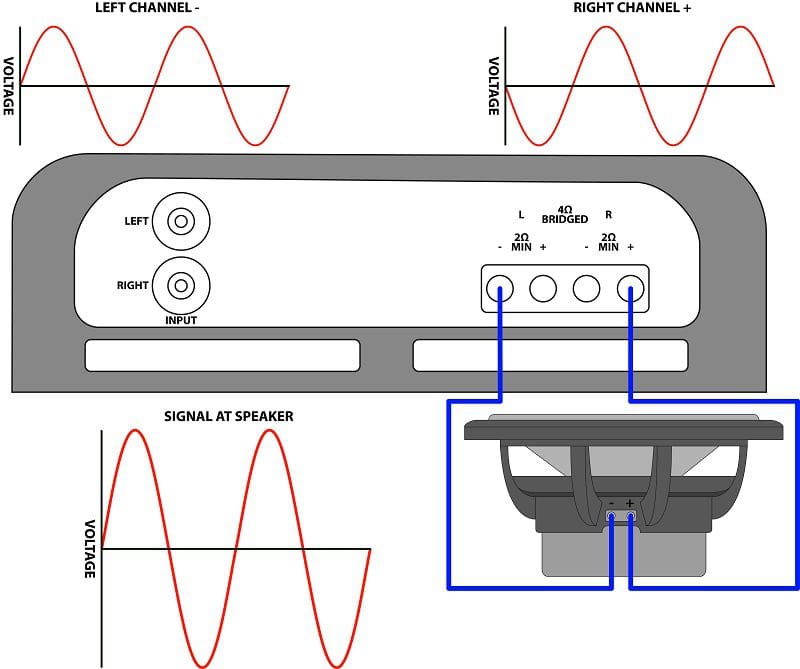


Each of these has two terminals: a positive terminal (+) and a negative terminal (-).įor the sake of this tutorial, let’s abbreviate these terminals to keep it straightforward. The two channels are the left channel and the right channel. On a 2 channel amp, there’s four of these. Get Familiar With Your Amplifierįirst thing’s first: locate the terminals on your amplifier. Most commonly, people bridge a 2 channel amplifier for a subwoofer, so that’s the example we’re going to use here. Now that you’ve double checked your amplifier, let’s get into the actual process of bridging your amplifier. Pioneer GM-A3702 -2 Channel Amp -500w Max Bridged Power – Automatic Signal Sensing How do you bridge an amp Planet Audio AC1600.4 – 4 Channel Amp – 800w Max Bridged Power 4Ohm- 6 Year Platinum warranty If your amplifier can handle it but your speakers can’t, you run the risk of blowing your speakers with that new power output.Ĭheck out these great amps – perfect for bridging! You also need to double check the speakers you’re going to use a bridged amplifier to power. There’s the possibility that your amp is bridged internally already and you shouldn’t double up on that. Since your amp’s impedance is halved, you run the risk of overheating it if this happens or if the unit isn’t designed for it.Īnother risk you run if you bridge an amp that doesn’t say it supports it is bridging one that’s already bridged. This is something you should be able to find in the documentation that came with the amp or on the unit itself.ĭon’t let your amplifier run below its minimum stated impedance (Ohms). The most important thing to do is make sure the amp says it can be bridged. Luckily, once you’re aware of these risks, they’re easy to avoid.
How to know which is right and left amplifier how to#
Risks And How To Avoid ThemĪs with any electrical project, there are a few risks you run when opening up your equipment and tinkering with it.


In these cases, it becomes a big benefit because it increases quality significantly. One way to avoid this drawback is to make sure you have top quality equipment, as some amplifiers actually thrive when bridged and running in monoblock. This results in harsher mids and highs, increasing the risk of distortion. One drawback of bridging is that occasionally an amplifier can fail to supply the right amount of current because of the reduced impedance. That’s the most common reason people bridge a car amp, so you’re most likely not going to worry about that anyway. This, of course, is no issue if you’re using a subwoofer. So, in order to get stereo sound, you’ll need a second one. That being said, a bridge amplifier operates in mono mode, meaning a stereo speaker becomes a mono speaker. This is because, since both use the same power source, you don’t need a DC-blocking capacitor. One of the major benefits of bridging is that it saves money and space. This is because there are both benefits and drawbacks to bridging, as well as the risk of damaging your amplifier if done improperly. There are a few things you should know before you bridge. Basically, this means that your speaker will resist less voltage when you power it up. When you bridge these channels, what happens is you give both channels the same audio signal with the polarity of one channel reversed.īy having one channel’s polarity reversed, you can double the voltage you’re able to power the amp with. With a bridged amp, you’re using lower impedance to drive higher impedance, maximizing your voltage transfer. In technical terms, this increase in power has everything to do with Ohms. How does an amp make more power when bridged? It both makes your sound system pack a bigger punch and allows you to save money by not needing as many amps. Increasing your power output kills two birds with one stone. This means you can pump almost twice as many watts to your speaker. When you bridge an amplifier, you combine a pair of channels into one channel configuration with half the resistance load (Ohms). If you’re replacing or upgrading your car’s sound system and need to figure out how to hook it up, you’ll probably need to bridge an amplifier at some point. This is a very common process, especially when it comes to sound systems with subwoofers. This reduces the resistance load or impedance of the amp (measured in Ohms). The term “bridging” refers to the process of combining and/or consolidating a pair of channels in an amplifier.


 0 kommentar(er)
0 kommentar(er)
